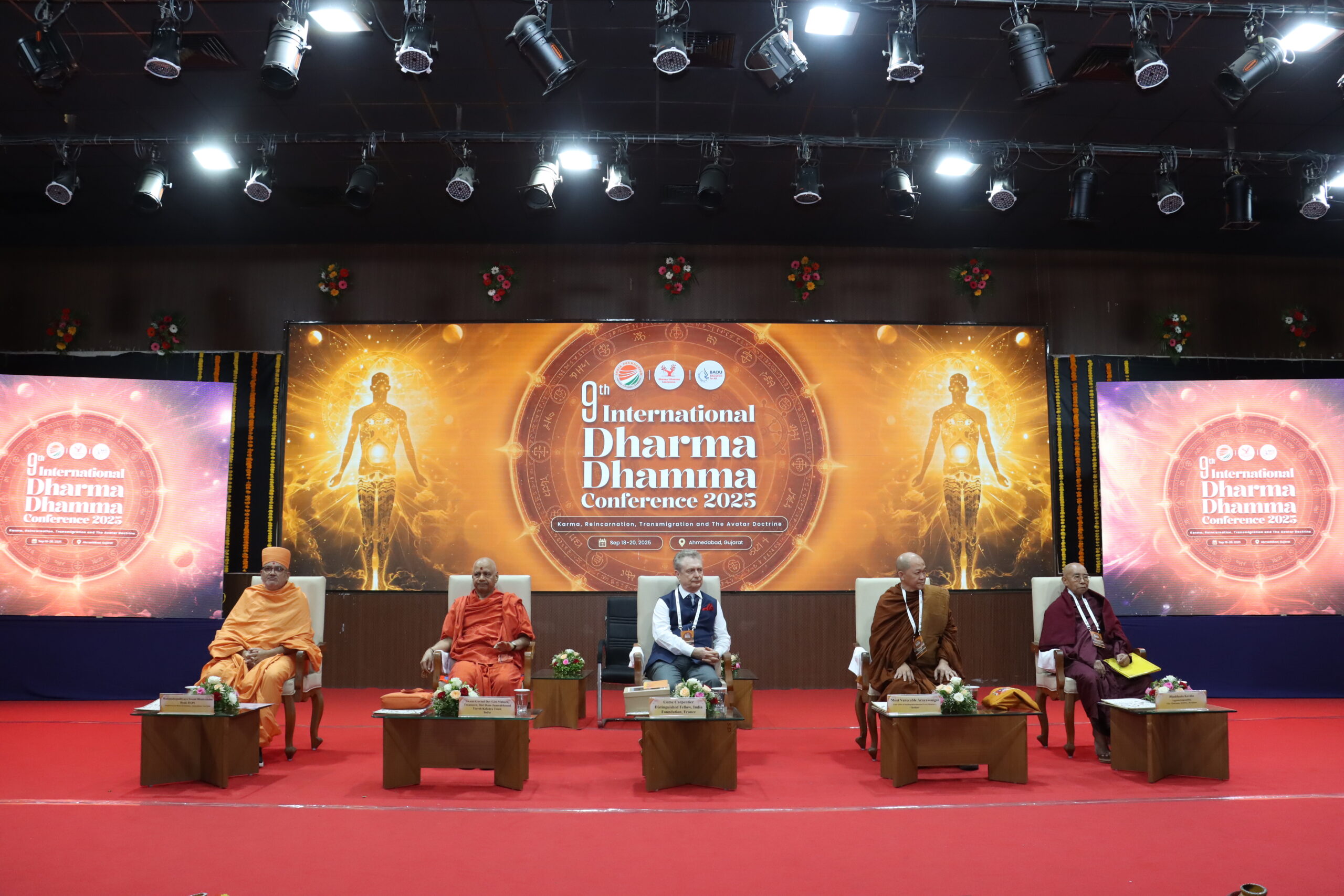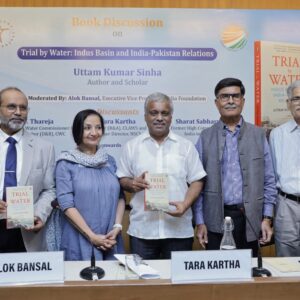Introduction
Harmony – In the context of music, it means “a pleasant musical sound made by different notes being played or sung simultaneously.” In a social context, it usually refers to “a situation in which people are peaceful and agree with each other, or when things seem right or suitable together.” However, an artist regards harmony as a combination of separate but interconnected parts in a way that employs their similarities to bring unity to a painting or any other object of art.
All the above definitions need to be recalled when discussing inter-religious harmony to see the underlying commonalities that bind various religions, primarily the spiritual seeker. In Indian religious traditions, harmony involves experiencing (anubhava) the Divinity that exists in every human being.
Bharat and Religious Traditions
Bharat has been a land of spiritual harmony since ancient times. Religious freedom, acceptance, and harmony are the very substratum of Bharatiya ethos. “Let noble thoughts come to me from all directions,” expresses the Vedas, and this indeed is an inherent nature of Bharatiyas. Sanatana Dharma teaches us to be reverential to life and nature around us.
Bharat has seen its share of a diversity of religions. Sanatana Dharma has allowed various schools/religions to spring from its essence and has accepted and accommodated many faiths. In the well-treaded path, significant turns were taken by many learned masters. New philosophies and practices were propounded by the leaders of these new religions. What reasons compelled them to develop and propagate a new belief system? In India, the reason was neither vanity nor self-seeking behaviour on the part of those who founded these religions, nor was it for practical conveniences. It stemmed from insightful investigations. For example, Nanak Dev, the first guru of the Sikh denomination, equipped his followers with an amalgam of social welfare and spiritual upliftment. In his time, this proved to be an effective method of bringing together many people who adhered to the path of devotion.
The religious and spiritual traditions of Bharat run more profound than mere faith. As noted by many commentators, Bharat’s religious, cultural, and spiritual practices are knowledge-based. Any interfaith dialogue needs to recognise this as it helps to outline, understand and communicate commonalities and differences. People who follow faith-based religions usually define the goal of human life as salvation through faith.
The oldest text of the world, the Rig Veda, proclaims, “The Truth is One, the wise express it in a variety of ways.” Sanatana Dharma recognises this maxim and constantly reiterates it through its literature to its society and people. The people of a country can remain united through the worst of times if there is a robust spiritual and cultural foundation.
Spiritual Oneness: The Vision that can lead to Harmony
Spiritual Oneness of the whole universe is India’s view on life, and Rishis of yore constantly strove to help people understand this idea. The Oneness expands from the individual to family, to society, to the nation, to existence, and to Ishvara. In light of this vision, all that is under our purview and that which lies beyond is Ishvara. This framework is ecologically sound and scientific in nature. We have borne the brunt of its after-effects whenever we have exploited nature.
Agriculture was adversely affected due to the indiscriminate use of pesticides that led to the death of earthworms, and it required a significant movement to impress upon farmers the need for vermicomposting. Research has suggested that wiping out the bee population will lead to humans’ extinction in about four years. Animals, birds, trees, plants, and all other beings are one with us, and nature is but an extension of humans. This is the basis of Sanatana Dharma. Most Indian religious traditions subscribe to this thought.
Those religions—or even some ideologies—that consider humans separate from nature and live with the assumption that nature is merely for the enjoyment of humans must mend their ways. Else, nature will continue to be exploited.
We face many life challenges, so we each need a solid support structure. Family, clans, community, religion, and society serve as this unwavering footing to successfully build our lives. But they are effective only if we can feel the connection with each one of these collectives – that feeling of Oneness. We are interconnected, interrelated, and interdependent. To emphasise this, Swami Vivekananda aptly declared, “One atom in this universe cannot move without dragging the whole world along with it.”
It is essential to record that Vedanta believes there are many paths to the one Truth. Each person on this planet has a unique mind and a distinct way thereof to reach the destination—the Truth. Depending on our individual nature, we need to approach this game of life. The Shiva Mahimna stotra voices: “As different streams having their sources in different places all mingle their water in the sea, O Lord, the different paths which people take through different tendencies, various though they appear, crooked or straight, all lead to Thee.”
Culture – the Injection to Infuse Doses of Oneness
The grand vision of Oneness which emphasises that nothing and no one is separate from us, needs to be imparted not through lectures or posts but rather through shared practices. India has been a land where many such shared practices constantly highlight the unity underlying all diversity. Namaste (namaskar) is how we greet people in this land of Bharat. This seemingly simple greeting has a deeper meaning. We internally recognise the Divinity in another and offer our prostrations to the divine within whom we meet. Worshipping animals, rivers, trees, inanimate objects, and so on are all age-old cultural practices of the land. Pooja/Upasana, festivals, and rituals are all forms of experiencing this vision of life. The Sanskrit word for festival is “utsava,” meaning “that which elevates.” Every festival is a means of elevating us.
If Truth is One, why is there turmoil in the name of religion? This perhaps is because those religions that come together in brotherhood allow into their exclusive groups only those that belong to their particular sect. Consequently, fissures and turmoil within the society is created. Religious conversion too is a significant problem to religious harmony. Swami Vivekananda, in the final session of the Parliament of the World’s Religions said on 27 September 1893: “The Christian is not to become a Hindu or a Buddhist, nor a Hindu or a Buddhist to become a Christian. But each must assimilate the spirit of the others and yet preserve his individuality and grow according to his own law of growth”. Following such advice would constitute an important step forward to enhancing religious harmony.
An exclusionary religion is a significant threat to religious harmony. In “inter-faith” conferences, there are globally accepted ethical practices on which religions claim to share common ground. The religions profess that they teach their followers to be compassionate to other beings, not to kill, steal, lie, etc. Such universal ethical principles are appreciated by all, including atheists.
When the theological laws and principles of various religions are explored, some of these “common” ethical principles are outweighed and overrun. If the religion teaches a set of laws that justify violating these fundamental moral principles, then harmony is disturbed. The adherents of that religion kill or convert people of other faiths claiming a religious justification for the same. Now it culminates in a fight between believers and non-believers. And if religious law and religious injunction stand taller than all other laws of acceptable behaviour, then an inter-faith dialogue becomes a non-starter.
Exploring some pathways to harmony
The first step towards arriving at harmony is perhaps acceptance of the belief of others. Meaningful dialogue between different faiths is critical in our journey towards harmony. Interfaith gatherings have transpired for a long time. To ensure that significant progress is achieved in such congregations, it becomes vital to arrive at an agreement on specific concepts, the most necessary of which is to accept that all paths are valid. We have seen earlier how Indian religious traditions revert to the idea of recognising all courses of the land as being valid. Not stopping at merely proclaiming the One Truth, it is backed by various devoutly adhered-to customs that put this concept into practice. Every religious faith should delve into the source of their knowledge and bring out the wisdom of their religion that points to a logical starting point—this elemental acceptance that all paths are valid. A firm commitment by leaders towards this quintessential goal sets a positive foundation for a harmonious society and nation. Acceptance may serve to be more impactful than mere tolerance.
Views from Inter-Faith Conferences
When asked to briefly talk about Judaism and Torah, Rabbi Hillel said, “What is hurtful or hateful to yourself, do not do to your fellow men.” One of the world’s oldest organised religions, the fundamental principle of Judaism has its core belief in the Unity and Oneness of the universal creator.
Take refuge in the Buddha, Dharma, and Sangha, say the Buddhists. In our current context of harmony, it is to rely on a state free from suffering, imbuing positive qualities and being beneficial to others. It is to rely on wisdom as the antidote to suffering. It is to associate with people of knowledge and understanding who are capable of guiding others in their spiritual journey.
Employing all available and impactful mediums of communication, be it social media, movies, books et al., to propagate this message of religious acceptance needs to be sketched as an essential activity for all religions. Today, more than ever, there is an irrefutable need for sensitivity towards our contemporary world. While interpreting the scriptures, there is a need to provide modern analogies. This requires a thorough internalisation of the faith’s core ideas. Many words in today’s context – like heathen, kafir, and mlechas – have acquired many hues for many reasons, including politics and irresponsible media. Religious influencers must ensure that using divisive language is strongly discouraged, which will, in turn, slowly begin to shift the minds of their followers.
Education – the best solution
Only when people in a society are educated about divergent faiths and beliefs can there be a shared understanding amongst them to plan a harmonious way of life. Does that mean the nation should shed its secular credentials and teach religion and moral values in school? While debates over this idea have been raging for many years, children and adults must understand the divergent faiths and beliefs that make Bharat.
A pressing concern for policymakers is what if the nation-state gets accused of promoting one religion over another. A variation to that concern is the fear of thrusting the nation’s majority religion that may lead to the oppression of minorities. Also, the interpretation of religion by teachers in school and parents at home may differ, and children may get confused with the inconsistency they encounter between what is taught at both ends.
Before addressing these concerns, it becomes essential to bring the focus of education upon the following:
- Character building
- Personality development
- Teach regional languages that hold the culture and traditions of the land. This will also enable us to unlock the treasure chest of literature in regional languages.
- Preserve nature, culture, and heritage.
There are consequences to not educating our children and adults on these issues. Consider a scenario where a religious minority in the country is unwilling to learn about other faiths. Typically, this has led to the nation conceding for religious or other institutions to be opened to impart spiritual and other forms of education. The child growing up in such a school/institution will not be exposed to other communities’ faiths. In numerical terms, this would mean that a minority percentage (significant or insignificant) of the population grows up in an excluded environment. This leads to them developing a sense of suspicion of people from other faiths. Having been brought up in such a setup, there is a greater likelihood of them falling prey to aggressive beliefs that may harm members of the rest of society.
A step in the direction of harmonization through educational policy
Education plays a primary role in creating a contemporary, integrated, harmonious India (and the world at large). It is an important step in the direction of harmonisation through educational policy. The new educational policy has tried to address many vital areas required to create a more integrated society. While many key aspects are addressed in the policy, some crucial areas relevant to our topic include:
- Recommendation for exposure to the rich literature in the various Indian languages by great Indian authors ranging from Tagore, Raghavanka to Kamban and Kabir.
- Recommendation for instruction in the local language of the area, learning of other Indian languages, and including a parallel instruction in English from Class 8.
- Recommendation of teaching history from a more native point of view.
Conclusion
Animals, plants, birds, water and celestial bodies, seasons, and even inanimate objects function in perfect synchronicity. In human relationships, we see sorrow and jealousy. To bring about harmony in human relationships, there is a need to develop thoughtfulness and respect between individuals.
As Swami Chinmayananda says, “To live a life of harmony is to recognise ourselves as members of an interdependent humanity, living in a composite universe. It is to merge our life with the resonant cadence of the whole and to bring about a beautiful melody of harmonious existence… Man has to be delivered from his own misconception of himself. When he develops respect for the Divinity in him, he develops a sense of holiness, and his reverence toward other human beings increases. Then alone can all economic, political, and social disturbances end. Religion or philosophy, whether reached through the church, mosque, or temple, cultivates in man this self-reverence. The seeker is taught to perceive a greater Reality, a greater and more divine Presence in one and all”.
Om Tat Sat
Author Brief Bio: Swami Mitrananda is a Spiritual Teacher of Chinmaya Chennai. He is Director National Projects, All India Chinmaya Yuva Kendra (AICHYK) and Publisher of Chinmaya Udghosh – an international youth magazine. Swami Mitrananda is an inspiring tutor, daring adventurer, vibrant speaker, creative writer, vigilant administrator & a mentor for many youngsters across the world.
References:
- Swami Vivekananda’s Speeches (The World Parliament of Religions, Chicago) Sept 27, 1893
- Ethics in Vedanta – Harmony or Ekabhava, https://www.chinmayaupahar.in/blog/ethics-in-vedanta-harmony-or-ekabhava/




